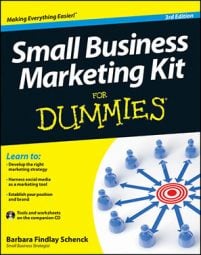Your small business needs to stay on top of the competition and your share of the market. Having a sense of your market share provides a good indication of your competitive rank and a way to monitor your growth within your target market.
Size up your small business target market
To calculate your share of the market, first define the size of the market in which you compete.
The total market includes the entire nation or world — a market area that matters enormously to major global marketers like Nike or Levi’s. But to a small business like yours, what matters is your target market — the one within the sphere of your business’s influence. You can assess your target market’s size by using the following criteria:
Geographic targeting: Where are your customers, and how many are there? For example, a retailer may determine that its geographic target market consists primarily of people who live or vacation within a two-hour drive of the retailer’s place of business. An accountant may determine that her geographic target market is concentrated within the city limits. A consultant may target businesses within a five-state region.
Customer targeting: How many people or businesses actually fit your customer profile? An office furniture manufacturer may target all the nation’s office-furnishing retail establishments, along with architects and interior designers who specify office furnishings. An online florist may focus exclusively on wedding planners and brides-to-be within a single state or region.
Product-oriented targeting: Sometimes, the most effective way to measure your target market’s size is through an analysis of how many sales of products like yours occur in the market. For instance, a microbrewery may measure its share of a market as a percentage of all premium beer sold in its geographic target area.
The microbrewery wouldn’t measure its sales against all beer sales; it would focus on premium beer sales, because that’s the microbrewery’s sphere of business influence. Likewise, an attorney who specializes in land-use planning would assess the number of land-use cases in the target market area before trying to calculate market share.
Several ways to calculate your small business market share
After you have a good sense of your total target market’s size, you can use several approaches to calculate your share:
Unit sales: Some businesses can easily figure out the total number of products like theirs sold each year. A motel manager in a region that collects a hotel occupancy tax, for instance, could divide the tax the motel pays by the total area-wide tax collection to arrive at the motel’s share of the market.
Number of potential customers: If you know that 30,000 adults are in your target market area, and if you can make an educated guess that one in ten of them — or 10 percent — is a consumer of services like yours, you can assume that your business has a total potential market of 3,000 adults. If you serve 300 of those adults, you have a 10 percent share of your target market.
To aid in your guesswork, visit the reference area of your library and flip through the Standard Rate and Data Service (SRDS) Local Market Audience Analyst to find out about consumers in your market area.
For instance, imagine a fabric and sewing supply store that serves a geographic area that includes 7,000 homes within a 15-minute drive of the store. The owners could find out from the Local Market Audience Analyst that 18.5 percent of the households in the area participate in home sewing.
If they multiply their 7,000-household market area by 18.5 percent, they’ll discover that they have 1,295 potential customers in their geographic market area. If the owners currently serve 250 of these potential customers, they have a market share of just less than 20 percent — meaning plenty of opportunity for growth.
Total sales volume: Another way to estimate market share is to calculate how much people spend at businesses like yours in your market area each year and then divide that figure by your sales revenue.
For example, if annually in your market area people spend a total of $1 million on products like those you sell, and if your business does $100,000 annually in sales, then you have a 10 percent market share.
Regional business journals and newspapers compile lists that rank sales by businesses in specific industries or service sectors. Businesses submit their revenues (often slightly inflated, so read them with a realistic eye) as a basis for appearing in these lists. Study the lists for your industry to find clues to regional sales revenues in your field.
Suppose that Green Gardens, a residential landscaping business, serves a market area that includes 20,000 houses, of which approximately 10 percent use landscape services. Thus, the potential residential landscape service market is 2,000 homes. If Green Gardens serves 200 homes, it has a 10 percent market share.
Another way to look at market share is by dollar volume. Green Gardens could estimate the revenues of each of its competitors and then add those figures to the Green Gardens revenue figure to produce a rough estimate of total target market residential landscape service sales. If target market sales total $4 million, and if Green Gardens has annual sales of $600,000, Green Gardens has a 15 percent market share.
If Green Gardens combines its knowledge of market share based on unit sales (number of houses served) and market share based on dollar volume, its owners would see that they have a 10 percent share of all houses served, yet they have a 15 percent share of total dollar volume.
This finding could lead them to conclude that they serve larger-sized accounts than some of their competitors. And based on that, they should have a small celebration!

